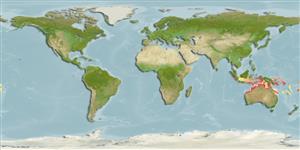>
Eupercaria/misc (Various families in series Eupercaria) >
Lethrinidae (Emperors or scavengers) > Lethrininae
Etymology: Lethrinus: Greek, lethrinia, a fish pertaining to genus Pagellus.
More on authors: Alleyne & Macleay.
Environment: milieu / climate zone / profondeur / distribution range
Écologie
marin; saumâtre récifal; non migrateur; profondeur 5 - 35 m (Ref. 90102). Tropical; 3°S - 23°S
Western Pacific: southern Indonesia, northern Australia, Papua New Guinea and the Solomon Islands. There has been considerable confusion in the use of names for this species. In recent literature it is referred to as Lethrinus fraenatus (a junior synonym of Lethrinus nebulosus) or Lethrinus fletus (a junior synonym of Lethrinus laticaudis).
Taille / Poids / Âge
Maturité: Lm ? range ? - ? cm
Max length : 56.0 cm TL mâle / non sexé; (Ref. 2295); common length : 35.0 cm TL mâle / non sexé; (Ref. 2295)
Épines dorsales (Total) : 10; Rayons mous dorsaux (Total) : 9; Épines anales: 3; Rayons mous anaux: 8. Cheek without scales; the inner base of pectoral fins densely covered with scales. Body is tan, brown or yellow with scattered irregular blotches; head brown or yellow with blue dots on cheeks and short blue stripes radiating in front and behind the eye, sometimes a number of blue cross stripes between the eyes; fines pale or yellow, the vertical fins are mottled.
Body shape (shape guide): fusiform / normal; Cross section: oval.
Juveniles found in seagrass beds and mangrove swamps. Adults found over coral reefs. Often in schools (Ref. 9710). Feeds mainly on crustaceans and fishes. Considered a good food fish. Marketed fresh (Ref. 9775).
Life cycle and mating behavior
Maturité | Reproduction | Frai | Œufs | Fécondité | Larves
Carpenter, K.E. and G.R. Allen, 1989. FAO Species Catalogue. Vol. 9. Emperor fishes and large-eye breams of the world (family Lethrinidae). An annotated and illustrated catalogue of lethrinid species known to date. FAO Fish. Synop. 125(9):118 p. Rome: FAO. (Ref. 2295)
Statut dans la liste rouge de l'IUCN (Ref. 130435: Version 2025-1)
Menace pour l'homme
Harmless
Utilisations par l'homme
Pêcheries: commercial; pêche sportive: oui
Outils
Articles particuliers
Télécharger en XML
Sources Internet
Estimates based on models
Preferred temperature (Réf.
123201): 26.3 - 28.8, mean 27.7 °C (based on 242 cells).
Phylogenetic diversity index (Réf.
82804): PD
50 = 0.5000 [Uniqueness, from 0.5 = low to 2.0 = high].
Bayesian length-weight: a=0.01479 (0.00699 - 0.03129), b=2.98 (2.81 - 3.15), in cm total length, based on LWR estimates for this Genus-body shape (Ref.
93245).
Niveau trophique (Réf.
69278): 4.5 ±0.8 se; based on diet studies.
Résilience (Réf.
120179): Milieu, temps minimum de doublement de population : 1,4 à 4,4 années (Preliminary K or Fecundity.).
Fishing Vulnerability (Ref.
59153): Moderate vulnerability (42 of 100).
🛈
Nutrients (Ref.
124155): Calcium = 36.6 [23.6, 61.2] mg/100g; Iron = 0.797 [0.506, 1.323] mg/100g; Protein = 20.6 [18.0, 22.8] %; Omega3 = 0.139 [0.091, 0.215] g/100g; Selenium = 33.4 [18.0, 60.4] μg/100g; VitaminA = 54.5 [11.0, 309.5] μg/100g; Zinc = 1.93 [1.34, 2.67] mg/100g (wet weight);
